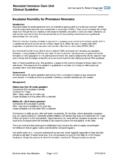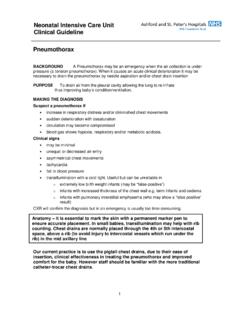Transcription of LISA (Less Invasive Surfactant Administration) with …
1 LISA ( less Invasive Surfactant administration ) with sedation We want to be able to give intratracheal Surfactant whilst minimising the adverse effects of ET. intubation with IPPV ( pneumothorax, volu/baro trauma). However we also want to minimise discomfort and pain, and laryngoscopy is uncomfortable. We want to reduce the risks associated with paralysis (hypotension, hypoxia). A conscious, lightly sedated baby will tolerate the procedure better and the procedure is more likely to be successful too. Whilst evidence suggests that atropine does not always protect against bradycardia, it probably does much of the time and it is safe and widely used. Chest wall rigidity due to fentanyl may not be as common as previously thought but we should be prepared for it. We are therefore aiming to have the baby conscious and breathing, but not distressed or agitated.
2 We aim to be prepared to escalate to full intubation/IPPV if necessary, and to be ready to reverse the effects of fentanyl if necessary. We use a one-third of the intubation dose of IV fentanyl. Wait for 5 mins to relax the baby without causing apnoea. If the baby is still unsettled after 5 minutes, a second one third dose of fentanyl can be given. Once the baby is settled, give a standard dose of atropine and commence the procedure straight away. Failure of procedure (2 attempts) will be followed by administration of more fentanyl with ET intubation and use of suxamethonium only if there is chest wall rigidity. We aim to place the fine tube in the trachea (2cm past the vocal cords) and slowly give Surfactant without the need for IPPV. The oxygen thresholds are based on the 2013 (Dargaville) data. Diagnosis of RDS ( Surfactant Deficiency / Hyaline Membrane Disease).
3 1. Does the baby need more intensive monitoring and/or treatment? a. For concerns about respiratory failure, transcutaneous pCO2 monitoring should be used b. Does the baby require arterial access for accurate blood gas monitoring? c. Should intensive care be escalated to start mechanical ventilation, or is it anticipated that the administration of intratracheal Surfactant will stabilise the baby? 2. Does the baby have RDS? a. Exclude a pneumothorax by careful transillumination of the chest b. Check that RDS is clinically likely (consider prematurity, antenatal steroids, sepsis likelihood, infant of mother with diabetes). c. Will a CXR add information? 3. Does the baby need Surfactant ? Think about O2 need and WOB. a. Increased work of breathing (WOB) due to RDS evidence of recession and tachypnoea, apnoea and/or shallow breathing, grunting, prolonged expiratory phase b.
4 Oxygen requirement if <28 weeks due to RDS FiO2 > & rising - for Surfactant c. Oxygen requirement if >28 weeks due to RDS FiO2 > & rising - for Surfactant d. The rate of rise in oxygen requirement should be considered e. Persistent respiratory acidosis despite optimal non- Invasive ventilation Intratracheal administration of Surfactant Preparation: Intravenous access Surfactant administration kit (NGT is too big in smallest babies). Forceps small Magill forceps OR non-toothed straight forceps (latter is sometimes easier). Atropine Fentanyl Suxamethonium Naloxone Suitable sized laryngoscope Have available (not opened): Suitable mask to deliver IPPV. Suitable sized ET tube with introducer and pedicap (Not opened). Preparation 1. Prepare fentanyl. The pre-prepared syringes of fentanyl are 10 micrograms in 2ml. The full.
5 Dose is 2 micrograms/kg (= ), but we will give one third (= ), rounded up to nearest It is easy to draw up further doses from the pre-prepared syringe if needed. 2. Prepare atropine, suxamethonium and naloxone in normal doses 3. Ensure baby will not get cold follow guideline before starting to prevent hypothermia . increase incubator temperature, blankets, swaddled effectively, consider transwarmer 4. Baby is likely to be on High Flow (Vapotherm) this should be continued through the procedure 5. Administer the dose ( ) of fentanyl and wait for a full 5 minutes for the peak effect to take place 6. Ensure baby can be positioned to facilitate easy laryngoscopy (no obstructions from incubator, suitable height for operator, good swaddling etc.). 7. Give atropine when baby sufficiently sedated it improves the tolerance of the procedure.
6 8. Monitor for apnoea and be prepared to give IPPV. 9. Grasp the fine tube using the Magill forceps with the distal part at 90 degrees to the tube, with about 3-4 cm of tube protruding Direction of Intratracheal tube placement Position of fine tube about 2cm into larynx. 10. Gently visualise the cords with the laryngoscope. Excessive pressure on the cords or vallecula will induce a bradycardia even with atropine present. If a bradycardia does occur, pause to see if it quickly resolves spontaneously; if not then stop and treat with oxygen if the oxygen saturations fall. 11. An assistant will be needed to help move the syringe as you move, they must ensure the syringe does not drag on the fine tube you are placing 12. As soon as the cords are visible, take the Magill or straight forceps with the tube grasped in place, and put the forceps straight down into the mouth towards the back of the throat.
7 Because the Surfactant tube is at 90 degrees to the forceps, it will be pointing at the vocal cords. Pass the fine tube forwards through the cords 2cm into the larynx/trachea. 13. Release the forceps carefully, ensure the fine tube is still in place. Secure the fine tube using a finger at the side of the mouth and then remove the laryngoscope. Do not leave the laryngoscope in place for any longer than absolutely necessary. 14. Keep your baby warm! The incubator should be closed during Surfactant administration . Check the baby is stable and breathing, and then start to give small amounts of Surfactant slowly over 5. minutes. 15. Give naloxone if apnoea or shallow breathing post-procedure to improve Surfactant distribution. Unsuccessful procedure Sometimes (more commonly in larger babies), the first dose of fentanyl is not enough to settle the baby for LISA.
8 Giving a second dose may help, but you must then wait a further 5 minutes before proceeding to give atropine and starting the procedure. If the procedure fails then prepare for intubation. Ensure the baby is stabilised, then use a further normal dose (2 micrograms/kg) of fentanyl. This will not be an overdose, as the dosing range is large. Place a suitable sized ETT and give Surfactant . Aim to extubate as soon as spontaneous breathing occurs and use naloxone if apnoea or breathing is shallow. Documentation Ensure that documentation of type of procedure as well as dose/time of Surfactant is recorded in notes and on Badger. This procedure will be subject to audit, so please complete a form every time you perform LISA and leave in Dr Reynolds' tray in Neonatal Consultants office. (Audit form is below ). LISA AUDIT FOR EACH PROCEDURE PERFORMED.
9 Date and Time of procedure: Baby's gestational age at birth: Baby's age at time of procedure (in days): Performing person's grade: Dose of Surfactant (mg/kg): Use of Atropine and dose (mcg/kg): Use of Fentanyl and dose (mcg/kg): Use of Suxamethonium and dose (mg/kg): Need for Naloxone and dose (mcg/kg): Baby on VT/CPAP/BiPAP/ventilator: FiO2 before procedure: FiO2 1 hr after procedure: Did O2 requirement fall slowly/quickly after LISA? Bradycardia <80/min? Yes / No if yes for how long Was LISA successful (if not why)? Did baby require intubation and ventilation? How did you find LISA overall? Which was the most challenging part? Did you feel comfortable performing LISA? Do you think there was enough support provided to you? What could be improved? Any adverse events/problems you want to mention? Do you have any other comments?
10 Guideline prepared and checked by Dr Peter Reynolds Updated April 2016. Updated August 2017.






